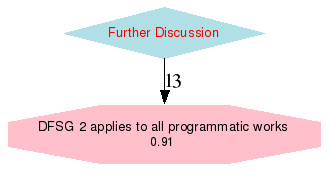General Resolution: Position statement clarifying DFSG #2
Time Line
| Proposal and amendment | Tuesday, 22nd August, 2006 | Friday, 25th August, 2006 |
|---|---|---|
| Discussion Period: | Saturday, 26th August, 2006 | Friday, 29th September, 2006 |
| Voting Period | Sunday, 1st October, 00:00:01 UTC 2006 | Sunday, 15thOctober, 00:00:01 UTC 2006 |
Proposer
Don Armstrong [don@debian.org]
Seconds
- René van Bevern [rvb@debian.org]
- Frank Küster [frank@debian.org]
- Pierre Habouzit [madcoder@debian.org]
- Alexander Wirt [formorer@debian.org]
- Kari Pahula [kaol@debian.org]
- Anibal Monsalve Salazar [anibal@debian.org]
- Sven Luther [luther@debian.org]
- Thomas Bushnell BSG [tb@debian.org]
- Marc 'HE' Brockschmidt [he@debian.org]
Text
Choice 1. The actual text of the resolution is as follows. Please note that this does not include preludes, prologues, any preambles to the resolution, post-ambles to the resolution, abstracts, fore-words, after-words, rationales, supporting documents, opinion polls, arguments for and against, and any of the other important material you will find on the mailing list archives. Please read the debian-vote mailing list archives for details.
DFSG #2 applies to all programmatic works
The Free Software movement is about enabling users to modify the works that they use on their computer; about giving users the same information that copyright holders and upstream developers have. As such, a critical part of the Free Software movement is the availability of source (that is, the form of the work that a copyright holder or developer would use to actually modify the work) to users. This makes sure that users are not held hostage by the whims (or lack of interest or financial incentive) of upstreams and copyright holders.
Different types of works have different forms of source. For some works, the preferred form for modification may not actually be digitally transferable.[1] For others, the form that originally was preferred may have been destroyed at some point in time, and is no longer available to anyone. However, to the greatest extent possible,[2] the availability of source code to users is a critical aspect of having the freedom to modify the software that is running upon ones computer.
Recognizing this, the Debian Project:
-
Reaffirms that programmatic works distributed in the Debian system (IE, in main) must be 100% Free Software, regardless of whether the work is designed to run on the CPU, a subsidiary processing unit, or by some other form of execution. That is, works must include the form that the copyright holder or upstream developer would actually use for modification.
-
Strongly recommends that all non-programmatic works distribute the form that the copyright holder or upstream developer would actually use for modification. Such forms need not be distributed in the orig.tar.gz (unless required by license) but should be made available on upstream websites and/or using Debian project resources.
-
Reaffirms its continued support of users whose hardware (or software) requires works which are not freely licensed or whose source is not available by making such works available in non-free and providing project resources to the extent that Debian is capable of doing so.
-
Requests that vendors of hardware, even those whose firmware is not loaded by the operating system, provide the prefered form for modification so that purchasers of their hardware can exercise their freedom to modify the functioning of their hardware.
Quorum
With the current list of voting developers, we have:
Current Developer Count = 1000
Q ( sqrt(#devel) / 2 ) = 15.8113883008419
K min(5, Q ) = 5
Quorum (3 x Q ) = 47.4341649025257
Quorum
- Option1 Reached quorum: 136 > 47.4341649025257
Data and Statistics
For this GR, as always statistics shall be gathered about ballots received and acknowledgements sent periodically during the voting period. Additionally, the list of voters would be made publicly available. Also, the tally sheet may also be viewed after to voting is done (Note that while the vote is in progress it is a dummy tally sheet).
Majority Requirement
All the amendments need simple majority
Majority
- Dropping Option1 because of Majority. 0.913 (136/149) <= 1
Outcome
The outcome
In the graph above, any pink colored nodes imply that the option did not pass majority, the Blue is the winner. The Octagon is used for the options that did not beat the default.
- Option 1 "DFSG 2 applies to all programmatic works"
- Option 2 "Further Discussion"
In the following table, tally[row x][col y] represents the votes that option x received over option y. A more detailed explanation of the beat matrix may help in understanding the table. For understanding the Condorcet method, the Wikipedia entry is fairly informative.
| Option | ||
|---|---|---|
| 1 | 2 | |
| Option 1 | 136 | |
| Option 2 | 149 | |
Looking at row 2, column 1, Further Discussion
received 149 votes over DFSG 2 applies to all programmatic works
Looking at row 1, column 2, DFSG 2 applies to all programmatic works
received 136 votes over Further Discussion.
Pair-wise defeats
The Schwartz Set contains
- Option 2 "Further Discussion"
The winner
- Option 2 "Further Discussion"
Debian uses the Condorcet method for voting.
Simplistically, plain Condorcets method
can be stated like so :
Consider all possible two-way races between candidates.
The Condorcet winner, if there is one, is the one
candidate who can beat each other candidate in a two-way
race with that candidate.
The problem is that in complex elections, there may well
be a circular relationship in which A beats B, B beats C,
and C beats A. Most of the variations on Condorcet use
various means of resolving the tie. See
Cloneproof Schwartz Sequential Dropping
for details. Debian's variation is spelled out in the
constitution,
specifically, A.6.
Manoj Srivastava

